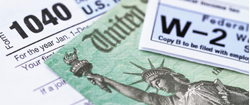The information in this article is up to date for tax year 2023 (returns filed in 2024).
Look, we get it. You’re not a tax professional. You’re just an ordinary person looking to save a few bucks by doing your own taxes. Whether it’s your first time or you’re a seasoned pro, the tax rules can tricky and at some point you’re bound to have questions. Luckily for you, ezTaxReturn is here to help you navigate your tax filing. We’re answering the 10 common tax questions, so you can avoid making costly mistakes.
How do I know if I need to file taxes?
Generally, you’ll need to file if your gross income was over the filing threshold. The amount you can earn before being required to file depends on your age, filing status, and whether you’re a dependent. The chart below shows the 2023 filing requirements for most taxpayers.
| Filing status | Age at the end of 2023 | Income |
| Single | Under 65 | $13,850 |
| 65 or older | $15,700 | |
| Married filing jointly | Both spouses under 65 | $27,700 |
| One spouse 65 or older | $29,200 | |
| Both spouses 65 or older | $30,700 | |
| Married filing separately | Any age | $5 |
| Head of household | Under 65 | $20,800 |
| 65 or older | $22,650 | |
| Qualifying surviving spouse | Under 65 | $27,700 |
| 65 or older | $29,200 |
You’ll also need to prepare a return if you earned at least $400 in self-employment income. For more details on who needs to file, check out IRS Publication 501.
Even if you didn’t make much money last year, it’s still a good idea to file anyway. You may be eligible for a refund of the taxes withheld from your pay or qualify for a refundable tax credit like the Earned Income Tax Credit. Don’t miss your chance to put extra cash in your pocket. Do your taxes with ezTaxReturn and we’ll help you get every dollar you deserve.
When is the deadline to file?
The tax deadline is April 15, 2024. However, if you need more time, you can request an extension which will give you an additional six months to file.
What documents do I need to do my return?
The most common form used to prepare a tax return is a W-2. Typically, you’ll receive a copy from your employer by the end of January. If your W-2 hasn’t arrived by mid-February, contact your current or former employer to request a copy. When you speak to them, verify your address to ensure they have your correct information on file. If the issue isn’t resolved by the end of February, contact the IRS at 1-800-829-1040 for assistance. In either case, you’re still expected to file your return by April 15th. Aside from your W-2, you will also need to have your social security number and bank account information for your refund handy.
How do I file?
There are a few ways to do your taxes. You can:
- Hire a professional,
- Use a tax software program, or
- Download the forms and fill them out yourself.
The fastest and easiest way to get the job done is to use ezTaxReturn. We’ll guide you step-by-step and guarantee that our calculations are 100% accurate. Plus, if you have a basic tax situation, you can file a FREE simple federal return.
How long will it take to get my refund?
Once your return has been accepted, the IRS issues most refunds within 21 days. However, it may take longer if your return requires additional review. Early filers must also keep in mind that if they claim the Earned Income Tax Credit or the Additional Child Tax Credit, their refund will not be issued before mid-February.
Where is my refund?
The best way to find information about your refund is to use the “Where’s My Refund?” tool on the IRS website. You can begin tracking your refund 24 hours after e-filing or 4 weeks after mailing your return. To get your refund status, you must enter your SSN, filing status and exact refund amount. From there, the tracker will show the status of your refund. You’ll see either one of three options; Return Received, Refund Approved or Refund Sent. There won’t be a refund date until the IRS has processed and approved your return. The fastest way to get your refund is to e-file and choose direct deposit as your refund method.
What is the best time of day to get through to the IRS?
Best advice is to call early in the morning. IRS phone lines are open Monday-Friday from 7am to 7pm (your local time). Residents in Hawaii and Alaska should follow Pacific time. They can be reached at 1-800-829-1040. During the filing season, the average phone wait time is 13 minutes. However, wait times tend to be higher on Mondays and Tuesdays, during Presidents Day weekend and around the April deadline. Have the following information handy when you call:
- Your Social Security number (SSN) or Individual Taxpayer Identification Number (ITIN) and birth date
- Filing status
- Prior-year tax return
- The tax return you want to discuss
- Any notices or letters the IRS sent to you
What happens if I file late?
If you can’t file by the deadline and expect to have a balance due, you may be slapped with two costly penalties. The first is a failure-to-pay penalty which is 0.5% of your owed taxes for every month it’s late, up to 25%. The second is a failure-to-file penalty which is 5% of your owed taxes for each month its late, up to 25%. Your balance will also accumulate daily interest. The interest rate is the federal short-term rate plus 3 percent. Even if you can’t pay by the deadline, at least file on time or request a filing extension.
How do I file a tax extension?
If you need more time to do your taxes, complete and submit Form 4868 to the IRS before April 15th. This will give you an additional six months or until October 15, 2024 to prepare your tax return. Keep in mind that requesting an extension only gives you more time to file without penalty, it does not give you additional time to pay.
How long do I need to keep my tax records?
Most taxpayers can shred their tax records three years after they’ve filed. Three is the magic number because that’s the amount of time the IRS has to audit you. It’s also the time limit for filing an amended return if you noticed a mistake after your return was accepted. However, there are some exceptions to the rule. If you file a fraudulent return or don’t bother to file at all, hold on to your records indefinitely. If you don’t report all your earnings and it’s more than 25% of the gross income displayed on your return, keep your records for 6 years. Finally, if you file a claim for a loss from a bad debt deduction or worthless securities, keep your records for 7 years.
The articles and content published on this blog are provided for informational purposes only. The information presented is not intended to be, and should not be taken as, legal, financial, or professional advice. Readers are advised to seek appropriate professional guidance and conduct their own due diligence before making any decisions based on the information provided.




